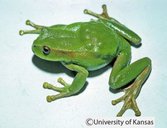|
Description
Diagnosis: Gastrotheca orophylax is distinguished from other frogs in the genus Gastrotheca by its lack of bold markings, which is only around the tympanum. The species lacks a pale labial stripe, a dark canthal stripe, a pale dorsolateral stripe and a pale supra-anal stripe (Duellman and Hillis 1987)
Description: G. orophylax has a SVL of 59 mm in males, and 74 mm in females. The head is wider than it is long; snout is rounded when viewed dorsally and truncate in profile with the nostril level with the anterior margin of the lower jaw; eyelid is half of the interorbital distance; diameter of eye is less than distance between eye and nostril; tibia length is 51% of SVL and longer than the foot. The skin on the dorsum is smooth in most specimens. The first digit on the forelimb is shorter than the second; discs on fingers are twice as wide as digits; webbing between digits extends to the penultimate tubercle or slightly beyond on the fifth toe (Duellman and Hillis 1987).
Coloration: The limbs, flanks and dorsum are uniform green. A bluish tint is on the anterior and posterior surfaces of thighs. It has pale cream colored ventral surfaces, and a grayish green vocal sac. It has a bronze tympanum (Duellman and Hillis 1987).
Distribution and Habitat
Country distribution from AmphibiaWeb's database: Colombia, Ecuador
The native range of Gastrotheca orophylax spans the upper slopes of the Andes Mountains in Ecuador and Columbia. It is found at elevations between 2,600-3,100 m above sea level. The habitat for G. orophylax includes primary and secondary cloud forests but it has also been found in reduced numbers in agricultural fields used for potato production in Ecuador. This species is exclusively terrestrial (Coloma et al. 2004). Life History, Abundance, Activity, and Special Behaviors
Gastrotheca orophylax is an Andean marsupial frog, meaning the female carries the eggs in a pouch. It is generally arboreal and found in cloud forests. Studies have shown that G. orophylax is a seasonal breeder. Collections during January, October, and December found no brooding females. In the months of March, May, June, and July, brooding females were found. These females gave birth in August and September (Duellman 1980).
Mating does not occur in the water, and this species shows axillary amplexus, where the male positions himself dorsally on the female’s back and grasps the female under her arms (Duellman and Maness1980). This species has a clutch size of 28, ovum diameter of 5 mm, and has a Type V pouch (Del Pino and Escobar 1981). With a Type V pouch, the mother must help remove all of the offspring from the small pouch opening using her hind legs (Duellman and Maness 1980). Duration of the incubation period in G. orophylax has been observed to be 88 days (Del Pino and Escobar 1981). G. orophylax has direct development, where it lacks free living tadpole stages, and its eggs develop into froglets (Duellman and Hillis 1987).
Male advertisement calls are short pulse group calls, with long pulsed calls being absent in G. orophylax. These calls have been described as repetitive, moderately loud “bonk-bonk-bonks”. The dominant frequency of these vocalized calls is 0.99 +/- 0.1 kHz with the call duration lasting 2465 +/- 419 ms, and a pulse group interval of 913 +/- 34 ms (Sinsch and Juraske 2006).
Trends and Threats
The population of G. orophylax is significantly reduced from previous decades and is continuing to decline. It is now an uncommon species in Ecuador. The major threats to the population are agricultural activity, human settlement and deforestation that cause habitat degradation. There is a need for better protection of its forest habitat. Other possible threats include climate change, chemicals used in potato farming, and disease (Coloma et al. 2004). Relation to Humans
This species occurs in agricultural fields used for potato production in Ecuador (Coloma et al. 2004). Possible reasons for amphibian decline General habitat alteration and loss
Habitat modification from deforestation, or logging related activities
Intensified agriculture or grazing
Urbanization
Local pesticides, fertilizers, and pollutants
Disease
Climate change, increased UVB or increased sensitivity to it, etc.
Comments
Species Authority: G. orophylax was first described by Duellman (1980).
Phylogenetic relationships: This species of marsupial frog is rare and was in the family Hylidae. However in 2005, it was moved to the family Hemiphractidae (Coloma et al. 2004).
References
Duellman, W. E., and Hillis, D. M. (1987). ''Marsupial frogs (Anura: Hylidae: Gastrotheca) of the Ecuadorian Andes: Resolution of taxonomic problems and phylogenetic relationships.'' Herpetologica, 43, 141-173.
Duellman, W. E., and Maness, S. J. (1980). ''The reproductive behavior of some hylid marsupial frogs.'' Journal of Herpetology, 14, 213-222.
Sinsch, U., and Juraske, N. (2006). ''Advertisement calls of hemiphractine marsupial frogs: II. Gastrotheca plumbea group.'' Herpetologia Bonnensis II. Proceedings of the 13th Congress of the Societas Europaea Herpetologica. M. Vences, J. Köhler, T. Ziegler, and W. Böhme , eds., , 149-152.
Stuart, S., Hoffmann, M., Chanson, J., Cox, N., Berridge, R., Ramani, P., Young, B. (eds) (2008). Threatened Amphibians of the World. Lynx Edicions, IUCN, and Conservation International, Barcelona, Spain; Gland, Switzerland; and Arlington, Virginia, USA.
del Pino, E. M. and Escobar, B. (1981). ''Embryonic stages of Gastrotheca riobambae (Fowler) during maternal incubation and comparison with development of other marsupial frogs.'' Journal of Morphology, 167, 277-295.
Originally submitted by: Hailey Pharmer, Bethany DeCourten and Felipe La Luz (first posted 2011-04-20)
Edited by: Brent Nguyen, Mingna (Vicky) Zhuang (2012-03-06)Species Account Citation: AmphibiaWeb 2012 Gastrotheca orophylax <https://amphibiaweb.org/species/1391> University of California, Berkeley, CA, USA. Accessed May 13, 2025.
Feedback or comments about this page.
Citation: AmphibiaWeb. 2025. <https://amphibiaweb.org> University of California, Berkeley, CA, USA. Accessed 13 May 2025.
AmphibiaWeb's policy on data use.
|
